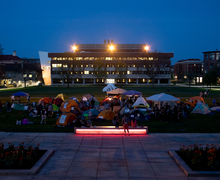Syracuse parents, students lack tech and training for remote classes
Jessica Ruiz | Contributing Photographer
Three of Medley’s nine children nearly a year ago. Medley was unaware that the schools had switched to Microsoft until days before the first week of school.
The Daily Orange is a nonprofit newsroom that receives no funding from Syracuse University. Consider donating today to support our mission.
At the end of six of her children’s first day of online school, all Darlene Medley could do was cry.
The Syracuse City School District began the 2020-2021 school year completely online Sept. 14. To Medley, a single mother of nine children who range from preschool-aged to adults, that meant an overwhelming day full of unfamiliar software, rejected passwords and crushing stress about what her children’s schooling would look like this year.
“I just closed the door behind me and I kept the kids inside, and I just kind of lost it,” Medley said. “I was so overwhelmed with not knowing what I was doing, and if I didn’t know what I was doing, my kids weren’t going to know what they were doing, and they were going to fail.”
SCSD’s Board of Education voted in August to conduct classes remotely until at least Oct. 2, after which teachers will begin using a hybrid model that brings students to school for a portion of the week.
Despite some assistance from the district, many students’ parents and guardians found themselves overwhelmed during the first week of school, unable to navigate unfamiliar software or lacking the technology needed to access it. Some fear the barriers to online learning will have lasting impacts on students’ education.
Prior to the start of the school year, SCSD purchased over 1,200 mobile hotspots and 6,000 laptops to distribute to students, said Michael Henesey, the administrator for communications for SCSD. Families in the district who did not have access to technology could fill out a survey requesting a laptop or hotspot for their children.
About 758 families requested a mobile hotspot and 3,500 families requested a school-provided computer prior to the first day of school, he said.
But some families didn’t receive the technology in time for the start of online classes. Patricia McCullars, who is the great grandmother and main caregiver for two children in the district, did not receive a computer for either of her children before the first week of classes.
McCullars’ great-granddaughter attends Mckinley-Brighton elementary school in Syracuse’s Southside. When McCullars called the school to request a computer for her great-granddaughter, school personnel told her that, while her child was on the top of their list to receive technology, the school still did not have a computer for her.
“They told her (Sept. 14) she would be at the top of the list but when we called, they still didn’t have any equipment available,” McCullars said. “This is now Thursday, so when is she supposed to get hers?”
Maria Face, who is the parent of one student in SCSD, said her son’s school never informed her that there was a laptop available for him.
Face had to purchase a phone for herself so her son could use her old phone to take his first-day of classes. She found the minimal communication from the school frustrating and unnecessarily stressful.
“It was an added expense that I wasn’t really expecting to have, that I didn’t really have the money for,” Face said. “But I had to do what was necessary for my son.”
While some parents didn’t fill out the district’s technology questionnaire ahead of the first day of school, the district sent out another order for necessary equipment that included 1,200 additional mobile hotspots and 4,000 additional laptops, Henesey said.
McCullars managed to find an old computer she had in her house for her children to use on their first day. But by the end of the day, the computer had crashed.
While she tried everything she could to help her great-grandchildren access their classes, much of the technology the school asked them to use was unfamiliar to her as well.
“Technology is what it’s all about now,” McCullars said. “You either use it or you get left behind. And I just don’t want (my kids) to be left behind right now, and I don’t want them to be behind because they haven’t been able to do school for a week now.”
Although Medley was able to secure remote learning technology for her children by the first day of school, she had trouble logging into her children’s accounts and did not know how to operate the district’s new software for online classes.
Parents did not learn until the week before school started that SCSD had switched much of the software it used for online learning in the spring to a Microsoft-based system, Medley said. Medley, who didn’t have a computer when the district informed her of the switch, had no way of learning how to use the new software.
“When Monday came, parents were all confused because, since March, we have been doing certain (learning) apps,” Medley said. “How were we supposed to learn the apps if we don’t even have the equipment?”
Medley, who recently had to leave her job to take care of her children during the pandemic, has had difficulty accessing Wi-Fi for her children’s classes. When she filled out the district’s survey about internet access, she was still able to access Wi-Fi in her house. But once she left her job, she was unable to pay for Wi-Fi.
“I have to figure out which bills am I going to pay, which bills am I not going to pay,” Medley said. “And to me, Wi-Fi is not a necessity over hot water.”
Medley has communicated with the school about her difficulty accessing the internet. But for many parents, coordinating with the schools isn’t as easy, she said.
“Me reaching out is kind of what gave me the upper hand,” Medley said. “But I know plenty of parents who wouldn’t (call) because either they don’t have the time and are essential workers in this situation, or they don’t know that they have the right to advocate for their child and say I need this or I need that.”
Technology issues in schools add frustration for families who are already under financial stress, said Bishop H. Bernard Alex, a member of the National Action Network’s Syracuse chapter. The network, which has raised $8,450 to purchase devices for students in the district, has delivered 30 laptops and is in the process of buying another 40.
This school year is especially difficult for parents who work, Alex said, since they have to balance their jobs with managing their children’s education.
“You have parents who are those frontline workers, who are the essential workers, a lot of them are the hands-on people,” Alex said. “They had to go back to work, they worked through the pandemic and they are not there to offer the child the guidance and support that they need.”
McCullars and her daughter—the children’s grandmother—take care of her great-grandchildren during the day. The children’s parents are essential workers who work during the school day.
Several Syracuse residents and educators, including Alex, marched from Dr. King Elementary School to SCSD’s Harrison Street offices Sept. 14 to demand answers from the school about its plans for remote learning and how students can access technology.
While Medley understands that nobody could have anticipated the pandemic, the district has known since March that the virus could affect the coming school year, she said. SCSD could have put plans in motion much sooner than it did, she said.
“There’s been a lack of communication from the district to parents,” Face said. “It kind of makes me wonder what they’ve been doing all summer. We’ve known that this was an issue since March.”
Teachers have stepped in where the district has fallen short in providing guidance to parents, Medley said. When she couldn’t log on to her son’s preschool class, his teacher walked her through all the steps to log in.

Many of Medley’s children’s teachers helped her navigate remote classes in the first week of school. Photo Courtesy of Darlene Medley
George Theoharis, a professor of educational leadership and inclusive elementary/early childhood education at Syracuse University, said school districts were unprepared for the start of the year because of a nationwide push to conduct classes in-person.
“As a nation, we’ve asked schools to solve safety and logistic questions when we should have asked them to solve safety and learning questions,” Theoharis said. “Leaders, principals and superintendents spent an inordinate amount of time over the summer planning for safety logistics rather than ensuring that students will be able to learn.”

Medley’s children nearly a year ago. Two of Medley’s children are immunocompromised and were impacted by lead in Syracuse’s water system. She opted to have her children take classes completely remotely. Jessica Ruiz | Contributing Photographer
But some parents in SCSD are choosing not to send their children back to in-person classes, even if the district transitions to the hybrid model. Despite the measures the school district is taking, Medley said sending her two children who are immunocompromised back to school would be too much of a risk.
“The hybrid format scares me,” Medley said. “Even though they are saying there will only be 29 or 26 kids in one class, it is just a little too much for me to be willing to take.”
Face worried that her son, who has autism, would have trouble getting into a routine with the hybrid format.
“Particularly children with autism, they thrive on routine,” Face said. “I’d be concerned about the hybrid model because it’s a break in routine two times a week and I don’t think that my child would handle that well.”
Alex, who worked for several years as an English teacher, said the technology issues some students are facing could also impact their education in the long run. This is especially true for students from low-income families, he said.
Students who are having difficulties learning online could become detached from the idea of school and won’t be excited about education, Alex said. If children don’t receive an adequate education early on, they’ll have trouble succeeding later in life, he said.
“If we don’t keep the children connected, that spark that will go to the blaze of the excitement of learning can very easily be squelched,” Alex said. “We need to keep them going forward because education is one of the key linchpin to get them out of poverty and break generational poverty.”
Despite the chaos, confusion and challenges that the first week of online learning posed, Medley has tried to make the experience fun for her children.
One day, she set up obstacle courses for them to complete. She built them foam cubicles to use during the school day. And she’s planning to buy each of her children their own headphones so they can block out distractions during the school day.
“These are moments that I will never get again,” Medley said. “My kids are growing up, so it’s stressful, but at the same time, if you’re a real parent and you really love your kids, you’ll do everything you can to make sure they are getting the most out of it. It’s tough, but you just have to be creative.”
Published on September 24, 2020 at 1:05 am
Contact Maggie: [email protected] | @maggie_hickss





